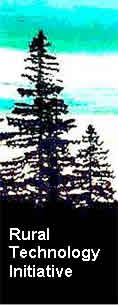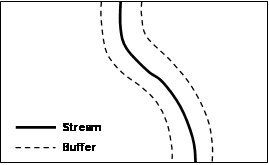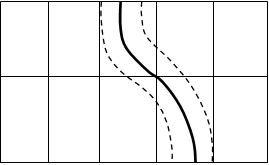 |
 |
 |
 |


Fact Sheet #02:
Case studies examining the economic impacts of the Forests and Fish
rules on NIPF landowners in Western Washington.
|
Revised May, 2003 By Kevin Zobrist Save or Print a PDF copy of Fact Sheet #02
The economic impacts of these buffers can be particularly burdensome for small forest landowners. Larger landowners can average their impacts over a large area (Figure 2a), but with small ownerships the impacts of buffers are concentrated on smaller areas (Figure 2b). This suggests that the impacts to small landowners are likely to be highly variable, as those with streams on their property may experience high impacts while those without streams may not be impacted at all. The purpose of doing case studies is to better understand these issues of variability and disparity and to see how individual landowners are impacted by the rules. Cases studies also offer opportunities to compare impacts between different management options. We looked at the extent to which the economic impacts would be reduced by doing the maximum allowable partial harvest in the riparian zone compared to treating all three zones as a no harvest area, which is the strategy chosen by most small landowners who have harvested under the FFR.
We also looked at the extent to which economic impacts would be
mitigated by participating in the Forestry Riparian Easement Program
(FREP). The FREP was established along with the FFR to help offset
the cost of the new riparian buffers to small landowners. Landowners
who participate in the program are given cash compensation at the
time of harvest for a portion of timber value that must be left
in riparian buffers. If the value of the required riparian leave
trees amounts to 19.1% or less of the total harvest value, then
compensation is given at 50%. If the value of required leave trees
exceeds a high impact threshold of 19.1% of the total harvest, 50%
compensation is given for the first 19.1%, while full compensation
is given for the remaining value in excess of 19.1%. Participation
in the FREP places a 50-year easement on the required leave trees.
Methods: To demonstrate the use of technology in addressing complex forestry issues, the latest computer software tools were employed to do the case studies. Spatial data for each case study was compiled using Geographic Information Systems (GIS). This data was then combined with forest inventory data in the Landscape Management System (LMS), a program developed at the University of Washington that integrates a suite of tools such as growth models and forest visualization programs. Using LMS, management simulations were done under the previous rules and then under the new rules. The harvest outputs from LMS were then put into spreadsheets for economic analysis. Several criteria were used to evaluate the economic performance of the new rules relative to the old rules for each case study. The first criterion is forest value, which represents the total value of a forest as an economic asset. This includes the economic value of both the currently standing timber and the land on which it stands given a target rate of return, which was a real 5% for this study. Land value (also called land expectation or soil expectation value) was then separated from forest value and used as an additional criterion. Land value is the residual value that remains after the existing timber is harvested, and it is based on the economic potential for producing timber rotations in perpetuity when starting from bare land. Land value is of particular interest because it demonstrates the economic performance of beginning a new rotation once the existing rotation is complete. Thus, it represents the economic potential for sustainable forest management.
Results: The results of the case studies are plotted in Figure 3
as a percent change in value relative to the previous rules (the
permanent rules that were in place before the FFR). The forest value
losses are most severe if no riparian harvest is done, treating
all three zones as no-cut areas. The impacts from that scenario
range from a best case 23% loss to a worst case 54% loss. If the
maximum allowable harvest is done in the inner and outer zones for
each case study, impacts range from a 17% loss to a 35% loss in
forest value. If the maximum allowable riparian harvest is done
and each landowner participates in the FREP, impacts range from
a 1% loss to a 12% loss.
The impacts on land value are more severe than impacts to total
forest value. If no riparian harvest is done, impacts range from
a best case 29% loss to a worst case 115% loss. If the maximum allowable
riparian harvest is done, impacts range from a 21% loss to a 92%
loss. Losses greater than 100% indicate that the target rate of
return can no longer be achieved.
Discussion: The results of these case studies support the idea that the economic impacts to small landowners from the FFR are highly variable and that the impacts will be severe for some landowners. The impacts are most severe if no harvest is done in the riparian zone. The results suggest that landowners can reduce their losses by doing the maximum allowable riparian harvest. However, even with maximum riparian harvest the losses are still substantial in some cases. Part of the reason that maximizing riparian harvest does not do more to minimize impacts is that calculating the allowable riparian harvest requires additional cruising and layout costs that offset any value recovery. Land value appears to be particularly diminished by the new rules, with some case studies losing most or all of their land value. Land value is lost in no-cut areas such as the core zone and parts of the inner zone, as the permanent retention of these trees precludes the use of the land for growing future timber rotations. If a significant portion of a given property is taken out of production because of buffer restrictions, it makes the entire property unprofitable in some cases, as there is now a much smaller production base to cover fixed overhead costs. Fragmentation may also make management unfeasible for the entire property in some cases. Significant decreases in land value imply that continued forest management will no longer be economically viable for some small landowners under the FFR. This will likely result in unintended consequences such as increased land use conversion. The results show that the FREP can be very effective at mitigating impacts. If each case study participated in the FREP, the magnitude and disparity of forest value losses would be significantly reduced. Part of the reason the FREP is so effective is that the 19.1% high impact threshold limits losses to a maximum of 9.55% of the total sale (50% of 19.1%). Since the timber qualifying for compensation under the FREP includes timber that had to be left under the previous rules, landowners can actually have a gain in forest value relative to the previous rules in some cases. The FREP also compensates for the extra layout costs associated with harvesting in the riparian zone, making it more economical to do the maximum riparian harvest. Unfortunately, current funding levels for the FREP fall well below the level required for large-scale participation, and future funding is uncertain. Consequently, the majority of small landowners will not be able to benefit from this program. Also, the FREP only compensates for standing timber; it does not compensate for the land on which that timber stands. Thus, it does not mitigate for losses in land value or address the associated long-term sustainability issues. Additional work is in progress to examine potential
alternate plans that would provide equivalent protection of aquatic
resources while minimizing economic impacts to landowners (RTI
Fact Sheet #23). Case studies
for Eastern Washington have also been analyzed (RTI Fact
Sheet #20). |







